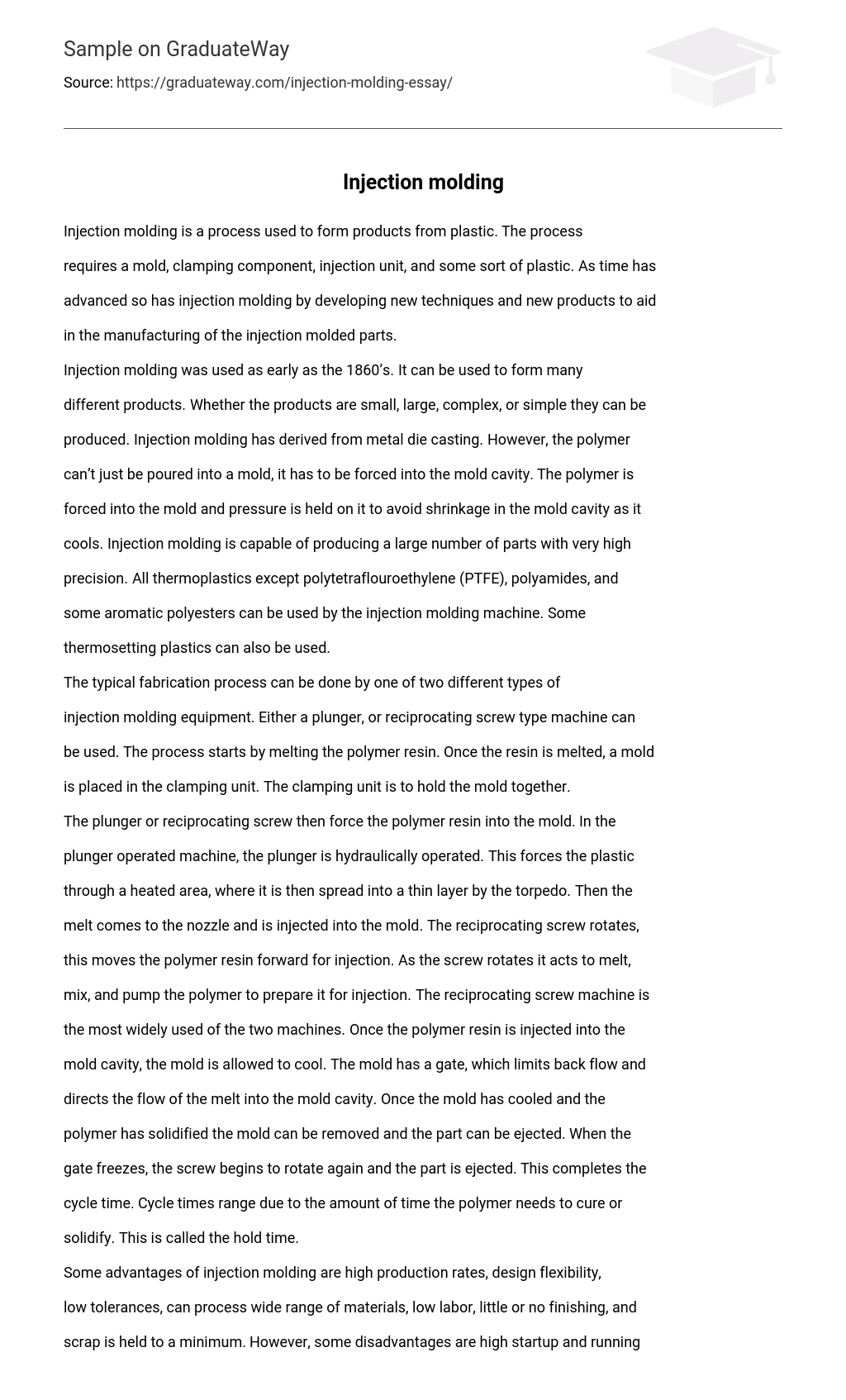The use of plastic in injection molding has facilitated the creation of various products. This manufacturing process incorporates a mold, clamping component, injection unit, and different types of plastics. Throughout its development, injection molding has introduced new techniques and products to improve the production of molded parts.
Injection molding is a versatile manufacturing process that has been used since the 1860s. It is capable of creating a wide range of products, regardless of their size or complexity. Unlike metal die casting, which involves pouring the material, injection molding forces the polymer into the mold cavity. The polymer is then injected and maintained under pressure to prevent shrinkage during cooling. This method offers high precision and can produce a large quantity of parts.
Most thermoplastics, except for PTFE, polyamides, and certain aromatic polyesters, can be used with an injection molding machine. Additionally, some thermosetting plastics are also suitable for this process.
There are two types of injection molding equipment that can be used to perform the typical fabrication process – either a plunger or a reciprocating screw machine. The process begins by melting the polymer resin, after which a mold is placed in the clamping unit to hold it together. The polymer resin is then forced into the mold by either the plunger or the reciprocating screw. In the plunger operated machine, hydraulic power is used to operate the plunger, which pushes the plastic through a heated area. This causes the plastic to spread into a thin layer by the torpedo before reaching the nozzle and being injected into the mold.
The process of injection molding involves the use of a reciprocating screw machine. This machine consists of a rotating screw that moves the polymer resin forward for injection. The rotation of the screw acts to melt, mix, and pump the polymer, making it ready for injection. This type of machine is widely used in the industry.
Once injected into the mold cavity, the polymer resin cools while inside. The mold cavity contains a gate which controls flow and prevents backflow as molten polymer enters the mold. After sufficient cooling and solidification, the mold can be removed and the part released. At this point, freezing occurs at the gate causing rotation of the screw to eject the part. This marks completion of one cycle in overall production.
The hold time, which is the amount of time needed for the polymer to cure or solidify, causes variations in cycle times. Injection molding offers several advantages such as high production rates, design flexibility, low tolerances, ability to process a wide range of materials, minimal labor requirements, minimal finishing requirements, and minimal scrap. However, there are also some disadvantages including high startup and running costs, the requirement for effective part design for molding, difficulties in accurately predicting costs, and the fact that high tooling costs are a result of building precise molds.
Injection molding molds are typically made of hardened tool steel, although softer metals like aluminum can be used if the lifespan of the tooling is not a concern. The cost of tooling can vary from $5,000 to $100,000. However, certain components can only be produced through injection molding and not by any other means. These parts become financially viable when manufactured in quantities of approximately 1,000 pieces. Considering the high cost of tooling, several factors must also be considered such as specific plant services that may be required for injection molding machines but not for other machines. As technology advances, the industry embraces automation to meet production demands.
Typically, operators engage in the task of placing parts into molds and then removing them. However, the current trend involves the use of robotic devices to insert inserts before molding and extract parts after molding, along with other operations. This implementation of robotics not only accelerates the process but also improves it significantly. Moreover, to keep up with technological advancements, the industry is now employing computer software known as “Mold Adviser.” Mold Adviser is a package for mold design and analysis that aids in expediting operations while reducing tooling costs. By utilizing traditional mold design methods, companies often faced time and monetary losses of six to twelve weeks and approximately $30,000 to $40,000 for correcting molds that faced filling issues.
The new software identifies these issues prior to the start of production, when used in conjunction with a CAD program. It consists of two main components: the Part Advisor and the Mold Advisor. The Part Advisor assesses the design and assesses whether the part will be filled correctly. Following this analysis, users can proceed to the Mold Advisor, which aids in gate and runner system setup, predicts plastic flow, shot size, and cycle time. Users have found this software to be user-friendly and easily learnable. Injection molded products encompass various items such as TV sets, VCRs, CDs, CD players, and computer housings.
Injection molding products have been influential in our daily lives since the 1860s, producing a wide range of products in different sizes and shapes. The constant advancement of injection molding, driven by technological progress and considerations for mold costs, is truly fascinating.
Works Cited
- Harris, Laura. “Injection Molding.” 30 Nov 1999. http://www.engr.uconn.edu/cheg/polymer/injmold.htm
- “Injection Molding.” 30 Nov 1999. http://www.endura.com/injmold.htm
- Mapleston, Peter. “New approaches show promise in large-part molding.” Modern Plastics Nov 1999.
- Snyder, Merle R. “Automation is gaining in vertical infection molding machine market.” Modern Plastics Aug 1996.
- Taylor, Gerry. “One-two punch knocks out injection-molding problems. Machine Design 17 June 1999: 80.





